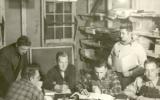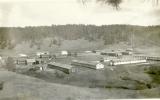CPS Unit Number 057-01
Camp: 57
Unit ID: 1
Operating agency: MCC
Opened: 10 1942
Closed: 5 1946
Workers
Total number of workers who worked in this camp: 507
-
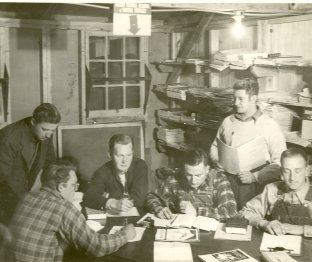 CPS Camp No. 57, Hill City, South Dakota.Six men in class. Progress and poverty class, course in Economics.Box 1, Folder 29. MCC Photographs, Civilian Public Service, 1941-1947. IX-13-2.2. Mennonite Central Committee Photo Archive
CPS Camp No. 57, Hill City, South Dakota.Six men in class. Progress and poverty class, course in Economics.Box 1, Folder 29. MCC Photographs, Civilian Public Service, 1941-1947. IX-13-2.2. Mennonite Central Committee Photo Archive -
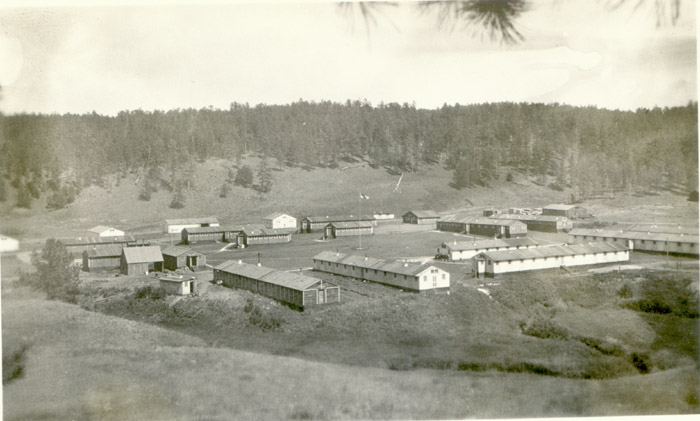 CPS Camp No. 57Civilian Public Service camp #57, Hill City, South DakotaDigital image at Mennonite Church USA Archives, North Newton, Kansasca. 1943
CPS Camp No. 57Civilian Public Service camp #57, Hill City, South DakotaDigital image at Mennonite Church USA Archives, North Newton, Kansasca. 1943 -
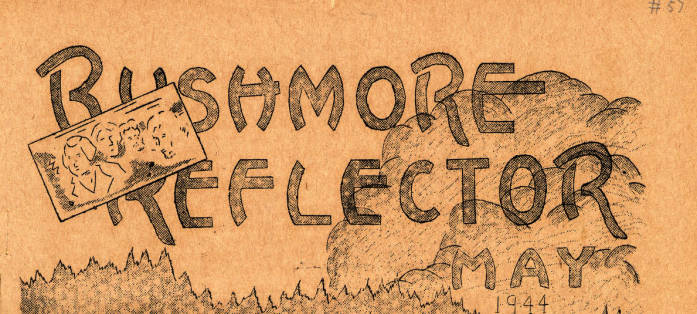 CPS Camp No. 57The Rushmore Reflector was a newsletter published by the men at Camp 57 from January 1943 to February 1946.Digital Image from American Friends Service Committee: Civilian Public Service Records (DG002), Swarthmore College Peace Collection, Swarthmore, Pennsylvania
CPS Camp No. 57The Rushmore Reflector was a newsletter published by the men at Camp 57 from January 1943 to February 1946.Digital Image from American Friends Service Committee: Civilian Public Service Records (DG002), Swarthmore College Peace Collection, Swarthmore, Pennsylvania
CPS Camp No. 57, a Bureau of Land Reclamation base camp located northwest of Hill City, South Dakota and operated by the Mennonite Central Committee, opened in October 1942 and closed in May 1946. The men finished building Deerfield Dam, a major irrigation project.
The Bureau of Land Reclamation opened its first CPS camp northwest of Hill City. The men of CPS Camp No. 57 described their location as follows:
Sixteen miles northwest of Hill City, in the heart of the Black Hills of South Dakota, is a long, beautiful, pine-covered ridge rising to an elevation of almost 7,000 feet. The summit of this rocky, limestone ridge is known as Flag Mountain. Approximately three miles to the southeast, in a valley several hundred feet below the top of the mountain, along a winding road, lies the camp site of CPS Camp Number 57. (The Voice of Peace, 1946, published by CPS No. 57, p. 32 in Gingerich p.164).
The temperatures would drop to forty degrees below zero in winter, and summer nights included occasional frost. In the harsh climate, many suffered from head colds, influenza and also a number of stomach ulcers.
To reach the nearest adequate market, staff and others travelled forty miles to Rapid City, South Dakota. Mennonite communities sent canned food to alleviate the inconvenience.
Directors: Paul Tschetter, Atlee Beechy,
Dietician: Marie Groening, Maria Wiebe
Nurse-Matron: Marie Lohrenz, Edna Peters
The first group of thirty-nine men came from CPS Camp No. 28 in Medaryville, Indiana. Two days later, ninety-seven new campers arrived from Kansas, Nebraska, Oklahoma and Indiana. Even though camp capacity was one hundred fifty, at one point the census reached one hundred sixty-seven. Over five hundred men worked at Hill City over the life of the camp.
In May 1945, men at the camp, when entering CPS reported affiliation with twenty different religious groups, the largest number from the (Old) Mennonites. Earlier in September 1943, of one hundred thirty-five men, thirty-five reported non-Mennonite denominational affiliation.
The men continued building Deerfield Dam, an earth and rock fill structure begun by CCC men. CPS man Victor Goering recalled in 2011 that the dam was "under ten percent completed" at the time the CPS men began the work in late 1942. In January 1945 construction engineer H. V. Hubbell, described the progress as "nearly sixty-seven percent complete" and he estimated that the work would be complete by the end of 1945. The clay core dam was to furnish a plentiful water supply for Rapid City which had inadequate and costly deep wells. In addition, the dam would provide a supplemental supply for twelve thousand acres of irrigated land to grow sugar beets in the valley downstream from Rapid City.
The dam was designed to be one hundred thirty-seven feet high above the foundation, eight hundred feet long across the top, seven hundred feet up and down stream at the base, and seventy-five feet in width at the top. "It will contain approximately 600,000 cubic yards of earth and rock fill, and 6,000 cubic yards of concrete. The reservoir will store 15,000 acre feet of water." (Hubbell in Gingerich, pp. 162-163)
The men worked three shifts around the clock at very difficult tasks including much hand labor with picks and shovels. At one point, men reported to work in temperatures of forty-three degrees below zero. The men operated power shovels, crawler tractors and other road-building machinery. They constructed forms for concrete reinforced with steel, poured and finished concrete.
Victor Goering wrote of this work at Hill City.
Although the primary reason given for the dam [on Castle Creek] was for a reservoir for Rapid City’s water supply, probably recreational use was also a large contributing factor. Preliminary work on the project had been done by the CCC several years before we began our work. We had a variety of different jobs the first winter. Some of us worked on tree removal, others on concrete walls and a concrete conduit, some were on a survey crew and various related tasks. The following summer we began filling in the dam with dirt which was hauled by trucks. The work force was divided into two groups so we could run two eight-hour shifts. It took more than three years to complete the work on the dam. . . . Today (2003) the Deerfield Dam is one of the best known recreational areas in the Black Hills. (The Eden Peace Witness: A Collection of Personal Accounts pp. 105-106)
In forty-one months, the CPS men spent 50,726 person hours on the dam, removed 152,750 cubic yards of dirt and rock during excavation, added 581,225 cubic yards of dirt fill, and used 9,340 cubic yards of concrete. (Gingerich p. 166) Men often referred to Deerfield Dam as “our Monument for Peace”.
The assignees also cut timber, fought forest fires, and performed repetitive and often insignificant tasks.
The men published The Rushmore Reflector from January 1943 through February 1946. The Rushmore Reminder, a weekly sheet of announcements and news began in May, 1944 when Roy Umble served as educational director. In 1946 the men told the story of their work at CPS Camp No. 57 in The Voice of Peace, a well illustrated work not unlike a college yearbook.
After a tornado damaged several ranches near the camp in June 1944, forty men donated over one hundred hours of free labor a few evenings later, to clear the highway and remove a destroyed barn, as an act of witnessing to the community. The grateful rancher commented, “This is the first time in my life I have ever seen a gang of fellows helping someone they didn’t know and would never see again. Where do you fellows come from anyway?” (from stories collected by Dr. J. Winfield Fretz in MCC central files as reported in Gingerich p. 291).
While few women worked on CPS camp staffs, they performed traditional roles as organizers, healthcare givers, food preparers, dieticians, and other related roles. As Goossen noted, many were viewed as “surrogate mothers or sisters”. (p. 71)
Marie Lohrenz, a woman in her early forties, performed duties as staff nurse at the camp. A single Mennonite woman from Minnesota often referred to as “Mom” by the men, she found the work demanding and satisfying. Marie, known beyond the camp for her nursing skills, even made house calls at no charge. In an interview with Goossen, she remarked, “Some of the neighbors who lived around the camp weren’t the friendliest to our boys, but they knew where to come when they were sick”. (p. 82)
John Thut conducted a ten-day summer music institute in 1944 at the camp.
Many camp men worked in leather crafts. According to one report, in December 1945 the men had made “over $2,000 worth of leather into billfolds, ladies’ purses, belts, and leather goods”. (Gingerich p. 332)
The camp enjoyed good public relations with the community for the most part. However, the editor of the Custer County Chronicle wrote several articles on his belief that “internees” were offered too much freedom to leave the grounds. On the other hand, sympathetic ministerial friends resided in both Hill City and Rapid City where COs found business relations to be congenial.
Ozzie Goering, recalling his experiences at Hill City nearly sixty years later wrote,
The time in Hill City was most enjoyable to me as I had the opportunity to learn to know many new people, including some non-Mennonites who were an inspiration to me. I also had time to read, and I read virtually every book in the library and took advantage of the many courses that were taught. I also decided that if I wanted to receive mail, I would have to write letters; however stamps seemed expensive and we were without pay. After about a year it was announced that each of the men would receive five dollars a month. I felt rich. (The Eden Peace Witness: A Collection of Personal Accounts p. 99)
For more information on Deerfield Dam and the Hill City, South Dakota Camp, see Melvin Gingerich, Service for Peace: A History of Mennonite Civilian Public Service. Akron, PA: Mennonite Central Committee printed by Herald Press, Scottdale, PA 1949, pp. 161-168.
For more information on women COs see Rachel Waltner Goossen, Women Against the Good War: Conscientious Objection and Gender on the American Home Front, 1941-47. Chapel Hill, NC: The University of North Carolina Press, 1997.
For general information on CPS see Albert N. Keim, The CPS Story: An Illustrated History of Civilian Public Service. Intercourse, PA: Good Books, 1990.
See The Eden Peace Witness: A Collection of Personal Accounts edited by Jeffrey W. Koller. Moundridge, KS: Jebeko Publishing, 2004.
Swarthmore College Peace Collection, Camp publications database.
